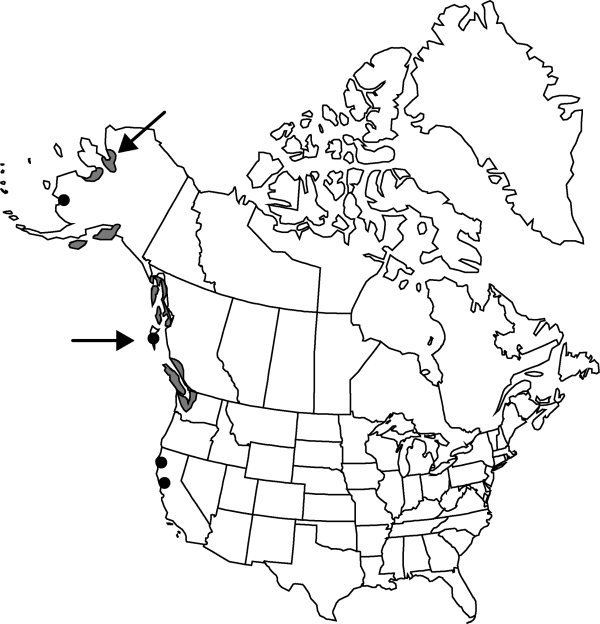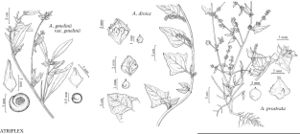Atriplex gmelinii var. gmelinii
Stems sprawling or erect to ascending, branched from base or rarely simple, 0.5–7.5 dm; proximal branches mostly elongated and prostrate. Leaves alternate, except proximalmost; petiole 0.5–1.5 cm; blade green on both sides, oblong to lance-oblong or linear, 9–100 × 1–50 mm, base mostly rounded to tapering into petiole or more rarely broadly cuneate from hastate base, margin entire, apex acute or acuminate or more rarely obtuse, glabrous or nearly so. Flowers glomerate in rather loose, spiciform inflorescences; staminate ones 5-merous. Fruiting bracteoles darkening at maturity, sessile or stipitate, ovate or lance-oblong to orbiculate, (0.5–)4–10(–25) mm, distinct nearly to base, margin entire or rarely with 1–3 teeth, apex acuminate to acute, often bulging on both sides of impressed midnerve, at first mealy, finally glabrate. Seeds dimorphic: some black, convex, 1.5–2 mm wide, lustrous, others pale brown, flat, 1.7–3 mm wide; radicle inferior or subascending.
Phenology: Flowering summer.
Habitat: Seashores, strands, salt marshes
Elevation: 0-50 m
Distribution

B.C., N.W.T., Alaska, Calif., Wash.
Discussion
Atriplex gmelinii var. gmelinii occurs with Elymus, Juncus, Salicornia, Distichlis, Arenaria, Glaux, and Mertensia. Plants included herein vary considerably both in stature from diminutive plants a few centimeters to very large ones to more than 7 dm, and they also vary in size and shape of leaves from linear to lanceolate or ovate. Dwarf plants with obovate or broadly oblong leaves form the basis of Atriplex drymarioides, which has been considered to be of conservation concern. Plants of similar stature but with narrower leaves occur commonly below the high-level oceanic tides, while plants with broad, thin and occasionally hastate leaves are present in immediately adjacent areas above the level of the tide.
Selected References
None.
